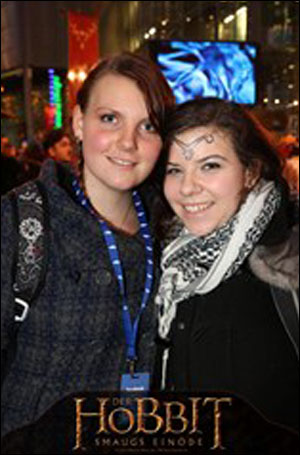When 500 recipients of VIP passes showed up at the European premiere of The Hobbit: The Desolation of Smaug, their priority was to obtain photographs showing them at the event, in costume and standing next to the movie’s stars, and to share the pictures with friends. To make that possible, Facebook and the film’s distributor, Warner Bros., opted for an RFID-based solution from Dwinq. As a result, the attendees’ VIP passes came with passive ultrahigh-frequency (UHF) EPC RFID tags, photographers carried RFID readers to interrogate those tags, and Dwinq’s Social Media Operating System software linked each picture with that person’s ID number, and then posted those pictures, along with The Hobbit logo, on his or her Facebook page.
During the single-evening event, the system connected the branded photos to nearly 100,000 individuals, based on an average of 240 friends for each of the 500 participants, with 132 percent sharing. This meant that the pictures not only reached 100 percent of the users’ own friends, but also any friends of their friends who may have liked or responded to the pictures.

The event itself, which took place on Monday, Dec. 16, was pandemonium when it came to picture-taking, says Patrick Sweeney, Dwinq’s president and CEO. The company has provided the Facebook-based solution at a variety of events, including the U.S. Olympics and Formula One races, he says, but this event stands out in terms of the high demand for pictures. “We’ve never had so many photographers for such a small group of people,” he states.
In fact, five photographers wandered through the premiere event taking pictures.
For the event, 500 people won the VIP passes through Facebook. Upon receiving the pass, each winner could either download a Dwinq app onto a mobile phone and then use it to register the pass or, upon arriving at the premiere, register via laptops located in the “Fan Cave.” In either case, the user input the ID number on the VIP pass, and then provided his or her Facebook user name and password, along with permission to link pictures to that Facebook page.
Every guest wore his or her VIP pass on a lanyard around the neck, each consisting of an RFID plastic ID card from Vanguard ID, containing an EPC Gen 2 UHF tag encoded with a unique ID number that was also printed on the pass. Photographers each carried an IDBlue pen-shaped RFID reader, as well as a Wi-Fi-enabled camera with an SD card loaded with Dwinq software, and a tablet or phone that received the tag ID read by IDBlue via Bluetooth technology, and then forwarded that data via a cellular or Wi-Fi connection. Photographers took pictures of the attendees (who were dressed up for the occasion, many in costumes based on characters from The Hobbit), either as groups of friends, or together with one or more of the movie’s stars.
After a photographer took a picture, the Dwinq software instructed the camera to send that photo to Dwinq’s cloud-based server. The photographer then took the IDBlue reader out of his pocket and tapped it near the attendee’s VIP pass, after which the reader interrogated the tag, collected its ID number and forwarded that data back to the server as well, via a Bluetooth connection with a tablet device.
Dwinq’s software on the server then linked the picture with that individual’s ID number. It collected the Facebook user name and password linked to the user’s RFID number, superimposed the logo from The Hobbit over the picture, and posted the image on the individual’s Facebook wall.
The picture was subsequently viewed on the “Newsfeed” of each user’s Facebook friend. “This was a pretty amazing event,” Sweeney says. “We’re really thrilled with the results.”
Dwinq was not only able to post Facebook pictures, but also collect data for Facebook and Warner Bros. that the companies could use for future advertising. For example, each individual who attended and participated in the Dwinq program could receive future advertising related to other Warner Bros. events. In addition, those who “liked” or responded to the pictures on Facebook could receive advertising. This provides a more direct connection between advertisers and consumers than traditional TV- or magazine-based advertisements, which can be difficult to track and are not personally directed at an individual consumer.
According to Sweeney, the solution requires some sophistication on Dwinq’s part to ensure that pictures are sent to the proper Facebook page, and that they are only sent once. For example, he says, it required considerable software engineering to be sure that if a photograph was taken of three people, each with an RFID tag, that photo would only be posted on each individual’s wall once, not three times. “That’s a real engineering challenge,” Sweeney states.

